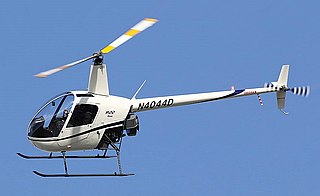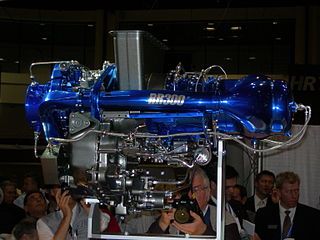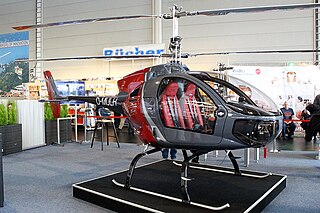The Robinson Helicopter Company, based at Zamperini Field in Torrance, California, is an American helicopter manufacturer. As of 2024, Robinson produces three models: the two-seat R22, the four-seat R44, both of which use Lycoming piston engines, and the five-seat R66, which use Rolls-Royce turbine engines.

The Robinson R22 is a two-seat, two-bladed, single-engined, light utility helicopter manufactured by Robinson Helicopter Company. It was designed in 1973 by Frank D. Robinson, and has been in production since 1979.

The Robinson R44 is a four-seat light helicopter produced by Robinson Helicopter Company since 1992. Derived from the company's two-seat Robinson R22, the R44 features hydraulically assisted flight controls and a larger engine. It was first flown on 31 March 1990 and received FAA certification in December 1992, with the first delivery in February 1993.

The Schweizer S300 series family of light utility helicopters was originally produced by Hughes Helicopters, as a development of the Hughes 269. Later manufactured by Schweizer Aircraft, and currently produced by Schweizer RSG, the basic design has been in production for over 50 years. The single, three-bladed main rotor and piston-powered S300 is mostly used as a cost-effective platform for training and agriculture.

Franklin Davis Robinson was an American aeronautical engineer and the founder of Robinson Helicopter Company in Torrance, California. He served as president, chief executive officer, and chairman of the company for many years. In the early 1970s, Robinson designed the Robinson R22 helicopter, a popular, light, two-place civilian aircraft, which later developed into the R44, one of the most successful civilian helicopters in history.

The Hughes TH-55 Osage is a piston-powered light training helicopter produced for the United States Army. It was also produced as the Model 269 family of light utility helicopters, some of which were marketed as the Model 300. The Model 300C was produced and further developed by Schweizer after 1983.

The Airbus Helicopters H145 is a twin-engine light utility helicopter developed and manufactured by Airbus Helicopters. Originally designated as the BK 117, the H145 is based upon the MBB/Kawasaki BK 117 C1, which became a part of the combined Eurocopter line-up in 1992 with the merger of Messerschmitt-Bölkow-Blohm's helicopter division of Daimler-Benz into Eurocopter. The helicopter was earlier named EC145; an updated version, EC145 T2, was renamed H145 in 2015.

The Schweizer 330 and S333 are turbine-powered developments of the Schweizer 300 light piston-powered helicopter. As of 2007, only the Schweizer 333 remains in production. In February 2009, the 333 was rebranded as the Sikorsky S-333. In 2018 the Schweizer R.S.G. bought the Schweizer Aircraft from Sikorsky Aircraft and it was rebranded as Schweizer S333 again.

The Rolls-Royce RR300 is a turbine aircraft engine (turboshaft/turboprop) developed for the light helicopter/general aviation market. Rated at up to 300 shp (224 kW) at take-off power, the RR300 is a rebadged and downrated variant of the Rolls-Royce Model 250-C20.

The Helicycle is a single-seat, semi-rigid two-bladed main rotor, helicopter powered by a Solar T62-32 engine. Manufactured by Helicycle Ventures LLC in Mesilla, New Mexico as a kit, the aircraft is intended to be assembled by the owner and is considered a homebuilt aircraft. The Helicycle was conceived and designed by B.J. Schramm, the founder of RotorWay International.

The Enstrom F-28 and 280 are a family of small, light piston engine powered helicopters produced by the Enstrom Helicopter Corporation.

The Guimbal Cabri G2 is a two-seat light helicopter produced by Hélicoptères Guimbal, and powered by a reciprocating engine. Designed by Bruno Guimbal, a former Eurocopter engineer, it had its origins in the 1980s, and the first demonstrator flew in 1992. Following the granting of regulatory approval, the Cabri entered commercial service in 2008. In addition to its use within the general aviation sector and as a training rotorcraft, the Cabri G2 has also been used as the basis for unmanned aerial vehicles (UAVs).

The Composite Helicopters International KC 518 Adventourer is a composite fuselage, 5-6 place turbine kit helicopter.

The RotorWay 300T Eagle is an American helicopter that was under development by RotorWay International of Chandler, Arizona, in 2009-2011. The aircraft was intended to be certified and supplied as a complete ready-to-fly-aircraft for the flight training and aerial work markets.

The Bell 505 Jet Ranger X (JRX) is an American/Canadian light helicopter developed and manufactured by Bell Helicopter. The Bell 505 was unveiled at the 2013 Paris Airshow in June 2013 as the Bell SLS. The Bell 505 designation was officially announced in February 2014. Its first flight occurred on November 11, 2014. The helicopter was certified by Transport Canada in December 2016. By 2023 about 500 have been sold, popular uses so far include for personal, sightseeing, law enforcement, and training.
The Midwest Zodiac Talon-Turbine is an American helicopter that was designed and produced by Midwest Engineering & Design of Overland Park, Kansas. When it was available the aircraft was supplied in the form of plans for amateur construction, but the plans are no longer advertised for sale.

The VRT 500 is a project of a light helicopter with a coaxial rotor developed by VR-Technologies (VRT), a subsidiary of Russian Helicopters.

The EDM Aerotec CoAX 2D/2R is a series of German coaxial main rotor helicopters designed and produced by EDM Aerotec of Geisleden. The aircraft is supplied complete and ready-to-fly.

The Curti Zefhir is a two-seat light-single turbine-powered recreational or trainer helicopter designed and produced by Italian aircraft manufacturer Curti Aerospace. Development was partly funded by the European Commission. It performed its maiden flight in 2017 and was commercially launched at the April 2018 AERO Friedrichshafen. Curti aim to secure type certification of the Zefhir as an ultralight aircraft.

Hélicoptères Guimbal is a French helicopter manufacturing company. The company produces the Guimbal Cabri G2.


























